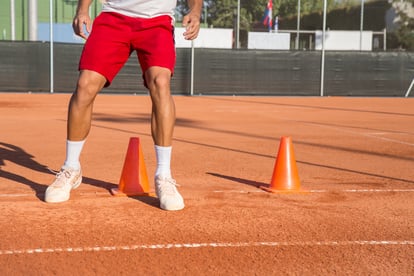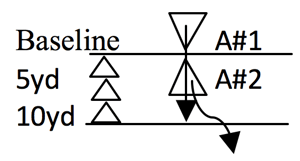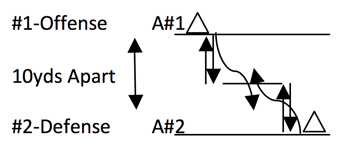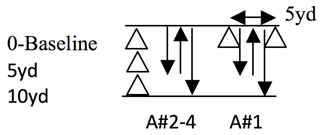 Agility drills basically represent an obstacle. Athletes who can respond faster to starts, stops, and change of direction earlier than the obstacle will have a practical advantage on the playing field. This blog highlights three of my favorite agility drills that can be built into your team’s conditioning routines. The benefits of these runs, jumps, and cuts include increases in reactionary speed, coordination, footwork, and body awareness. Athletes need to be able to change direction rapidly under control without decreases in speed.
Agility drills basically represent an obstacle. Athletes who can respond faster to starts, stops, and change of direction earlier than the obstacle will have a practical advantage on the playing field. This blog highlights three of my favorite agility drills that can be built into your team’s conditioning routines. The benefits of these runs, jumps, and cuts include increases in reactionary speed, coordination, footwork, and body awareness. Athletes need to be able to change direction rapidly under control without decreases in speed.
You will need a good strength base before doing any high-intensity agility drills. These three drills are great for giving athletes the ability to keep their eyes on the play while knowing what is around them. Adding teammates to the mix always makes it fun and competitive.
Enjoy the drills!
 Drill 1: Offense/Defense—Partner Reaction Acceleration Tag
Drill 1: Offense/Defense—Partner Reaction Acceleration Tag
Setup: Cones are spaced 10 yards apart with a middle cone at the halfway point.
Number of Athletes: 2
Athlete 1: Offense (starts the drill); Athlete 2: Defense (reacts and chases)
Execution: Both athletes start on the ground head to head on the baseline. Athlete 1 starts the drill and is allowed two fakes before they must stand, turn, and sprint 10 yards. Athlete 2 reacts and chases Athlete 1 once they stand and turn and has 10 yards to catch and tag Athlete 1 in a sprint fashion.
 Drill 2: Cat & Mouse—5-5 Shuttle Reaction Tag
Drill 2: Cat & Mouse—5-5 Shuttle Reaction Tag
Setup: Cones are spaced 10 yards apart with a middle cone at the halfway point.
Number of Athletes: 2
Athlete 1: Offense; Athlete 2: Defense
Athletes will face each on opposite sides 10 yards apart.
Execution: At the start of a whistle or cue, both athletes sprint a 5-yard shuttle 5–5.
Athlete 1 then tries to sprint past the midline as fast as possible before Athlete 2 tags him before passing the midline after they both do a 5-yard shuttle.
After the 5-yard shuttle, Athlete 1 can juke/cut, etc. to get to the midline to fake out Athlete 2 before being tagged. Athletes switch between offense and defense.
 Drill 3: Shuttle Runs—Reaction 5-5-10 Shuttle
Drill 3: Shuttle Runs—Reaction 5-5-10 Shuttle
Setup: Cones are spaced 0, 5, and 10 yards apart.
Another set of cones is 5 yards apart on the baseline.
Number of Athletes: 3–4
Athlete 1: Shuttles (drill start); Athletes 2–4: Reactionary
Execution: At start of a whistle or cue, Athlete 1, facing the baseline, begins shuffling between the 5-yard cones. Athletes 2–4 stand facing the other way on the baseline waiting to react to Athlete 1. Athlete 1 can shuffle back and forth for a total of two times. However, within the two shuffle attempts, Athlete 1 can turn and sprint whenever. Athletes 2–4 must respond to Athlete 1 and turn and sprint. After Athlete 1 initiates the sprint shuttle, all athletes are now in a race to sprint a 5–5–10-yard shuttle.
This blog was written by Michael Blume, MS, SCCC; Athletic Performance Coach. To learn more about the NIFS bloggers, click here.

